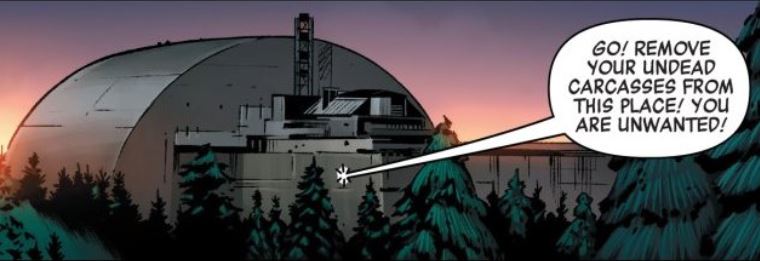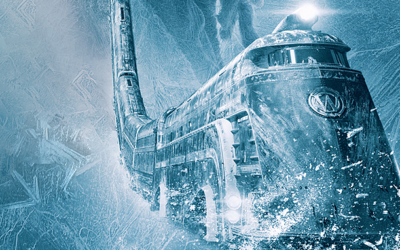Meanwhile, as if things weren’t bad enough, over in Marvel’s Avengers, vampires have taken over Chernobyl.
Okay – more specifically, they appear to have taken over the New Safe Confinement structure which safeguards the remains of Reactor 4, which exploded in 1986.
Need more background? Okay – let’s go…
Setting the Mood…Some Avengers & Dracula Context
So over in the monthly Avengers series(*), written by Jason Aaron with art by Ed McGuiness and a handful of guest artists, the team mostly consists of a group of Marvel movie and television all-stars – the usuals: Captain America, Iron Man, and Thor; the “next generation:” Black Panther, Captain Marvel, and Doctor Strange; the television: Ghost Rider, Phil Coulson; the in-development: She-Hulk, Moon Knight (coming in issue #33) and Namor; and the O.G. – Blade. Oh, and Celestials…and Dracula.
Now – minor history lesson here – Dracula has been around the Marvel Universe for decades. First appearing in The Tomb of Dracula #1 in 1972, the character (pretty much the straight-up Bram Stoker version) had his run as an anti-hero, a sympathetic villain, vampire warlord and king, and as an out and out villain over the years. He’s fought Spider-Man, the X-Men, Captain Britain, the Avengers (prior to this), and, of course, Deadpool. Oh, and there are a lot of vampires in the Marvel Universe.
The current vampire storyline in Avengers has been building for a while now, which has kept Blade hanging around Avengers HQ, which is at the North Pole, located in the body of a dead Celestial.
Yeah, it’s complicated.
So anyway…in issue #32, Dracula and his high-level vampire management team were shown to be holed up in Ukraine, The Chernobyl Exclusion Zone. Dracula was granted the zone by the Russians in an earlier issue and part of a larger deal. From what we’re shown in the issue, the vampires have taken up residence in what looks to be an abandoned wreck – broken windows, rust, structures falling apart, and a giant bat prepping to eat a bus full of tourists (who apparently got a good deal on the tour…)
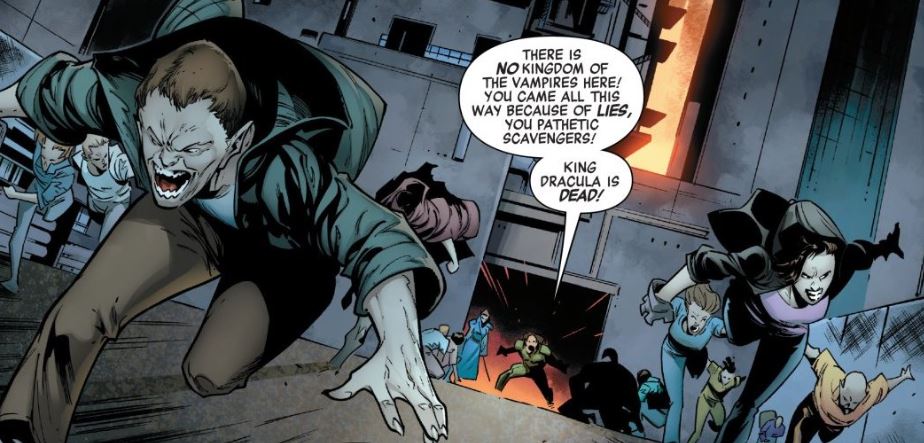
Wannabees told to beat it – get away from the NSC (c) Marvel Comics
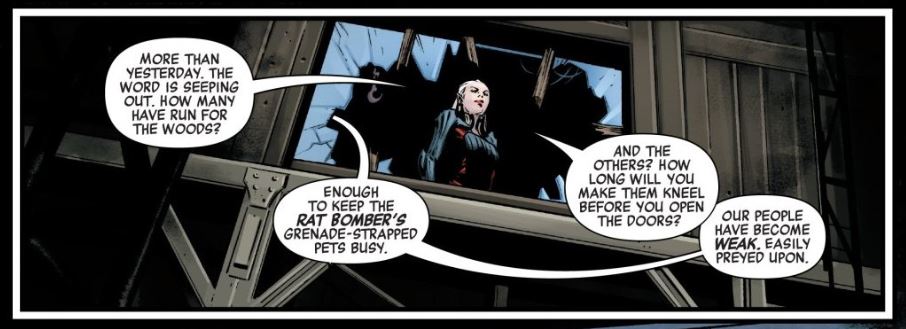
That’s a pretty wrecked office…and yeah, Rat Bomber is a thing (c) Marvel Comics
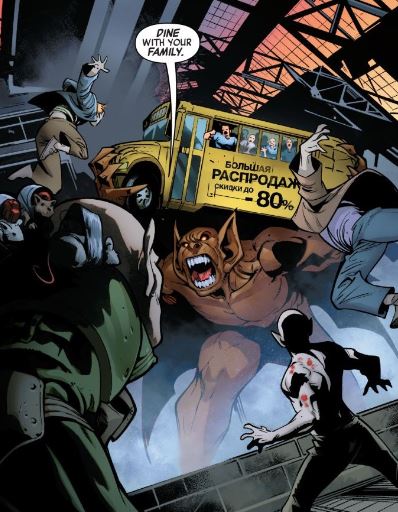
How to know you picked the wrong day for a tour… (c) Marvel Comics
Let’s talk about specifics of his base of operations…
Building a Better…Building
The Chernobyl Exclusion Zone refers to an area around reactor 4 – the one that blew up in 1986. Roughly, the Zone is a circle around reactor 4 with a radius of 30 km. Other regions have been added into “Exclusion” status over time, with the area of the entire zone coming in at under 3,000 km2.
As for what happened back in 1986, we’ll let The Science Of pal Kyle Hill(**) explain…
Or, you know, you can watch the miniseries on HBO. It’s a fictionalized account of the accident/disaster but gets across a lot of what really went on.
So, an explosion on April 26th – that’s been pretty well covered. In June through November of that same year, a massive concrete and steel structure was built over reactor 4, with the idea of sealing in the still hot (radioactively and physically) nuclear fuel. Building the structure, officially called the Shelter Structure, but nicknamed the “sarcophagus” was by any measure of construction work, insane. It started with digging a tunnel under the fuel to build a pad that would (hopefully) stop the nuclear fuel from burning through the bottom of its containment structure.
The sarcophagus was built as best it could be in the 5 months, and was constructed with holes to observe the nuclear core, as well as filtered ventilation to allow hot (physically, not radioactively) air to get out.
But ultimately, the sarcophagus just wasn’t going to last. It’s designed lifespan was 20-30 years.
Worst-case scenario? The structure collapses in on the still hot (radioactively) reactor 4, and sends up a massive plume of radioactive dust that drifts over Ukraine as well as Europe, just like the original accident – oh, and nuclear material is exposed to the atmosphere. Best case scenario? There really wasn’t one. Maybe the sarcophagus lasts a little longer than its engineers thought?
A more permanent fix was needed. The plan that was decided upon was something that a six-year old could’ve brainstormed: build a bigger building over the big building that’s falling apart, which is built over the blown-up building with the bad stuff in it.
The Ukranian government opened an international design contest for new structure (opened it to engineering firms, not six-year-olds), and in the end, the idea from Design Group Partnership of Manchester, UK won out. DGP’s proposal was pretty incredible – an arched structure that would cover reactor 4, including the iconic chimney would be built off-site and then slid over the sarcophagus and reactor 4. The construction would have to be down to the centimeter perfect, as there was to be no open room in the end of the arch as it slid over the building.
Construction of the New Safe Confinement (NSC) structure was a massive, multinational effort that started in September of 2010, and the completed NSC came to final rest on November 29th, 2017 after a 15-day journey of just under 200 meters. Total cost: around $1.7 billion dollars.
The construction of the NSC was fully documented, and well worth your time to check out. To date, the arched structure is the world’s largest movable land-based structure. The video below was produced by the European Bank for Reconstruction and Development, which financed the project.
Chernobyl and the NSC in Our World (no Vampires…sorry)
The obvious goals of the NSC are to contain what’s inside, as well as reduce any further corrosion of the sarcophagus and reactor 4 complex, and mitigate any problems that could arise as the result of a partial or entire collapse of the structures it covers. But there’s one more major goal, and this strikes right at the heart of pop culture depictions of Chernobyl’s reactor 4 over the years – the demolition of what’s inside the NSC.
In our reality, the NSC and the complex around reactor 4 isn’t some abandoned wasteland. Sure, Pripyat, the nearby city is abandoned and the whole “Exclusion Zone” thing keeps a large number of people out – there were 187 small communities in the greater Chernobyl area. Some individuals have returned – some are original residents, some are…others who’ve chosen to live there for their own reasons. Watch any extreme travel show, and you’ll see tours through the Exclusion Zone – which are often much less thrilling than the hosts make them out to be. All told, several thousand people work in the Exclusion Zone. It’s a weird, but not abandoned place. It has its own state management agency. A large solar energy array has been set up in the Exclusion Zone as well.
Most recently, of course, the region has been in the news due to nearby forest fires, the smoke from which is elevating the local radiation levels.
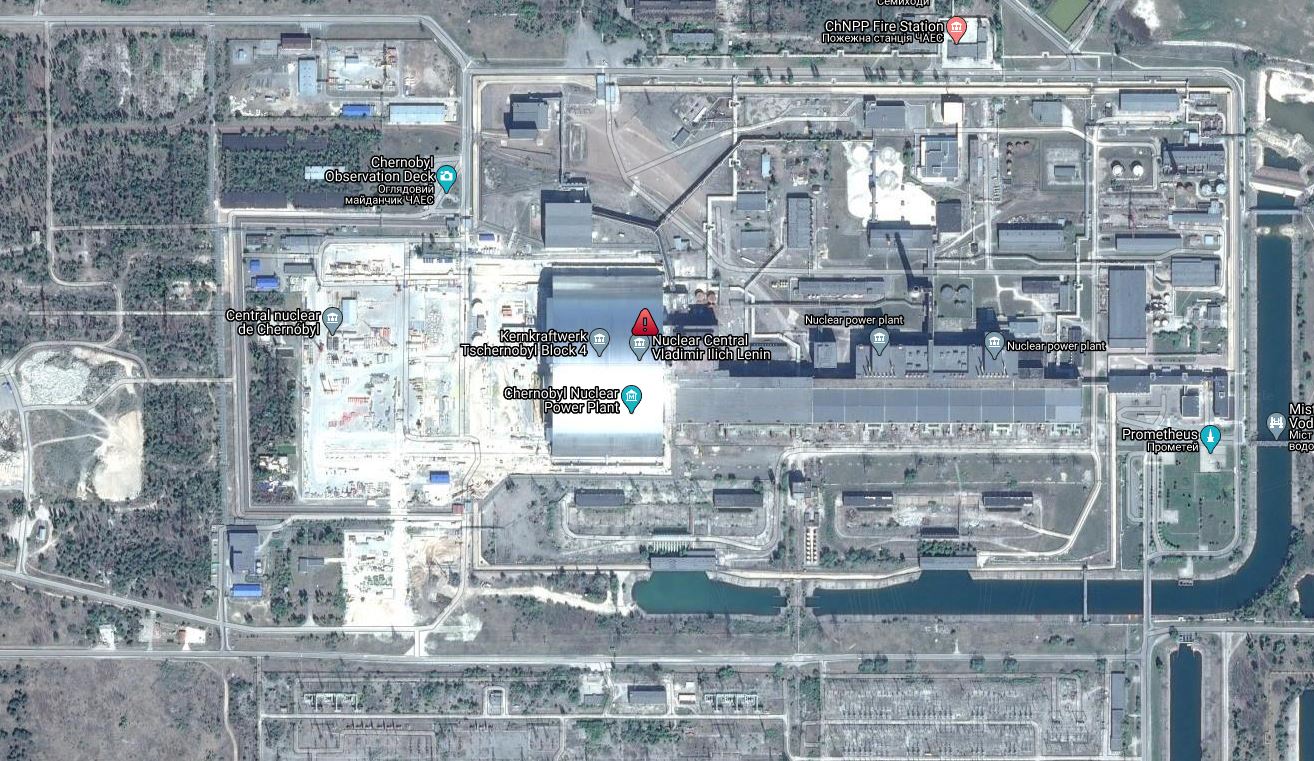
The Google Earth view of the NSC
And in the center of it all? Currently, the NSC is a hub of activity, and has been since construction was completed. There’s still radiation that did occasionally hamper work in the NSC, but the site has been up and running for a handful of years. It’s even been open to the media since July of 2019. It’s well-lit, well-ventilated and looks like a modern industrial setting.
Arches and beams inside NSC support cranes which methodically pick away at the ruins of reactor 4 and the sarcophagus. There are dozens of cameras throughout the site which allow the roughly 3,000 people working in and around the NSC to work safely without exposure to hard radiation. As you can imagine, workers are carefully monitored for radiation exposure, and according to accounts, must wear two dosimeters, one short-term exposure and one for long-term.
According to reports, the sarcophagus is about ready to collapse, according to reports – and that would not be good. The company responsible for dismantling the sarcophagus estimates that the process will be complete by 2023 – and will be both building supports and carefully taking apart the structure over the coming years. The sarcophagus material will be decontaminated as best as possible before being shipped off site for recycling or ultimately, disposal.
Once the sarcophagus has been dismantled, work will begin on the massive effort to clean up the area of reactor 4, including the radioactive “lava” composed of radioactive fuel (still hot – physically and radioactively), sand, lead and boron which emergency workers dumped on the reactor in 1986 in an effort to stop the fire.
The workers at the NSC have time – the structure was designed to last 100 years. And that’s the majority of the work that will be going on at the site, aside from the decommissioning of Chernobyl’s other reactors, which were shut down in 2000. As for when the site will be “safe” safe – the reactor and its immediate structure will be radioactive for 20,000 years.
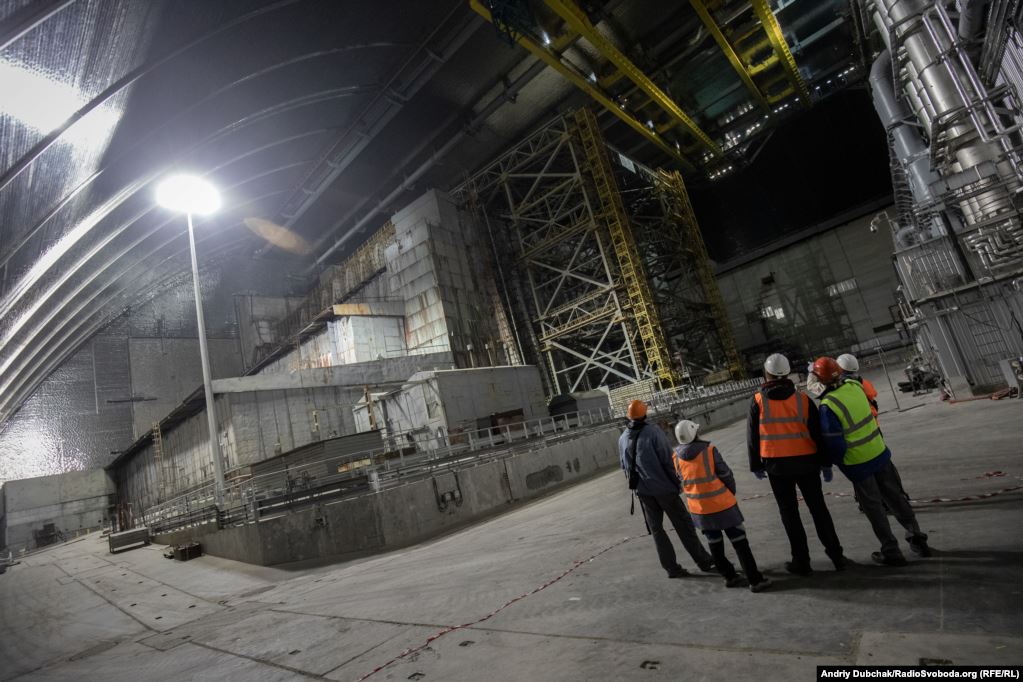
That gray structure surrounded by scaffolding is the sarcophagus (c) Radio Free Europe
Chernobyl & Pop Culture
As always, our mission here isn’t to rain on parades. In the Marvel Universe, the NSC is what it is – and probably has a brief, brutal (and unseen/untold) backstory about vampires taking over the Exclusion Zone, which would be awesome. You can just see it now, can’t you? See? Awesome.
And that’s fine. Since the accident in 1986, Chernobyl and Pripyat have been irresistible for pop culture settings (Transformers: Dark of the Moon, Chernobyl Diaries, Die Hard: A Good Day to Die, The Strain, Volume 2: The Fall, Call of Duty 4: Modern Warfare, STALKER) or just inspiration, such as mirroring a power plant accident which became the instigating event which lead to the Federation-Klingon peace talks in Star Trek VI: The Undiscovered Country. The mention in Avengers isn’t even the first time Chernobyl has shown up in the Marvel Universe.
As a location, an event and as a shared history, Chernobyl has its own gravity that pulls creators to it. That’s going to be with us for years and years, if not centuries. But once you start to learn and follow the reality of the event and the location…the real story is an equal match for any fiction.
(*)Hey – a quick word about the comic book itself. Right now – most comic shops around the country are shut down, and Marvel, DC, or any of the other major comic book publishers are putting out new comics, either digitally or in print. There’s a serious concern within the industry right now about the comic book market surviving this crisis. If you’re interested in the issue, or any comic book at all, really – do us here at The Science Of a solid, and first, locate your nearest local comic shop, and secondly, check with them about mail order. Virtually all comic shops are fighting for their lives right now, so if you have the means, and have been looking for an issue (maybe Avengers #32), a graphic novel, or there’s an action figure that you’ve had your eye on, throw them some dollars and grab it. We’re all in this together, and speaking personally, comic books have brought us so much over the years…let’s try to help out the retailers on the front line.
(**) Hey (part 2) – a quick word about Kyle. He’s since left Nerdist and struck out on his own with The Facility. It’s Patreon-supported and he’s cranking out new content like a madman. If you loved his work on Because Science, you’re going to love The Facility even more. Go over and check it out, ‘kay?


